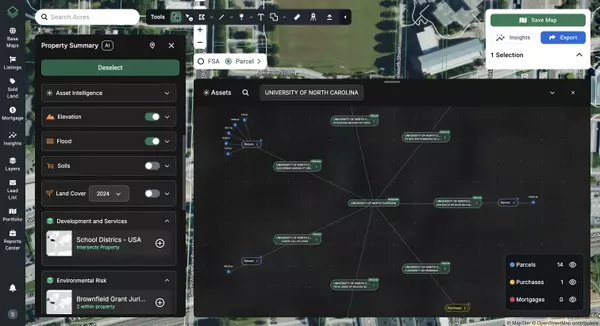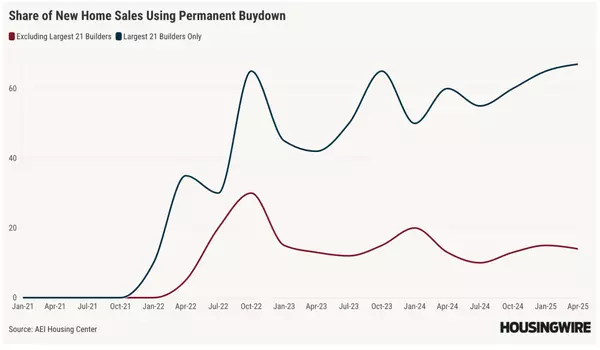Beazer Homes shifts to move-up buyers, bets on energy efficiency

As major builders like D.R. Horton and Tri Pointe Homes trim new home starts to protect margins, Beazer Homes is taking a page out of Lennar’s playbook. Beazer’s Q4 earnings call reveals a builder determined to sustain a robust sales pace, even as it navigates a lower-margin reality driven by a spec
Read MorePHH Mortgage will halt reverse originations, sell MSRs to Finance of America

Onity Group — the parent company of PHH Mortgage Corp. and its reverse mortgage arm, Liberty Reverse Mortgage — announced on Tuesday that the company has entered into a “strategic relationship” with Finance of America (FOA) to sell $9.6 billion in mortgage servicing rights (MSRs), among other agreem
Read MoreWhen land strategy meets AI: homebuilders gain a new edge

Strategic paralysis in a buyer-stuck market If land is the lifeblood of homebuilding, then today’s land strategy is a pressure test of a company’s core strength. But how do you act when the market offers no clear signal? After a chaotic four-year stretch of feast, famine, and fiscal policy shockwave
Read MoreBright MLS to integrate ICE’s Paragon Connect platform

ICE Mortgage Technology and Bright MLS, the nation’s largest multiple listing service (MLS), announced that Bright will integrate ICE’s Paragon Connect MLS platform into its technology ecosystem as part of its long-term growth strategy. Paragon Connect is a mobile-first MLS platform designed to let
Read MoreForeclosure activity up nearly 20% in October

ATTOM released its October 2025 U.S. Foreclosure Market Report, showing 36,766 properties with foreclosure filings — including default notices, scheduled auctions or bank repossessions — a 3% increase from September and more than a 19% increase from a year ago. October marked the eighth straight mon
Read MoreIs NAR’s move to allow non-Realtors MLS access a nothing burger?

Starting in January, local MLSs will have a lot more control over things like disciplinary actions and even who can access the MLS. These changes are the result of an 18-policy update approved by the National Association of Realtors’ (NAR) executive committee during the trade group’s NXT conference
Read MoreSenate Democrats demand GAO investigation into Pulte

A group of Senate Democrats has asked the Government Accountability Office (GAO) to investigate Federal Housing Finance Agency (FHFA) Director Bill Pulte and other employees over criminal referrals against several public figures as they seek to determine whether federal authority and resources were
Read MoreJason Cao joins Tidalwave as COO

Tidalwave, an agentic AI mortgage technology startup integrated with Fannie Mae and Freddie Mac, recently announced the hiring of Jason Cao as chief operating officer. Cao, an early investor in Tidalwave two years ago, was most recently COO at CertiK, where he helped build it into a unicorn as the w
Read MoreMortgage-rate dip lifts affordability to a three-year high, sparks a fall housing flurry

Century 21 expands in central Florida

Century 21 Real Estate has expanded its presence in the Orlando metro area through the affiliation of Hancock Realty Group in Clermont. The move brings the Lake County brokerage — now operating as Century 21 Hancock — under the Century 21 banner as it marks its 10th year in business. Century 21 Hanc
Read MoreOregon agents launch Christie’s International Real Estate Evergreen

A group of longtime top-producing Oregon real estate professionals has launched a new brokerage, Christie’s International Real Estate Evergreen, that marks the brand’s latest expansion on the West Coast. The firm is led by veteran broker Brian Pienovi, his son Andrew Pienovi and Patrick Clark, one o
Read MorePulteGroup expands into Cincinnati market

PulteGroup announced plans to expand its Ohio operations, including an entry into the Cincinnati market. In a press release, Tony Barbee, PulteGroup’s North Area president, said that the company is well-positioned for success in Cincinnati due to its already established presence in the state. “Thi
Read MoreBerkshire exits D.R. Horton, adds to Lennar — what it means for homebuilders

While headlines scream that Berkshire Hathaway has taken a $4-plus billion position in Alphabet, a quieter, “closer-to-home” move slips into the latest 13F filing. In the same quarter that Berkshire built its stake in Google’s parent, it closed out its position in D.R. Horton and added to its stake
Read MoreFathom Holdings reports 38% revenue growth, ancillary service expansion

Fathom Holdings is leaning into expansion, agent productivity initiatives and stronger ancillary service performance — reporting double-digit growth across its core operations in the third quarter. Revenue rose 38% year-over-year to $115.3 million, while agent count climbed 24% and transactions incr
Read MoreFormer Fed Governor Kugler violated financial trading rules, filings show

Former Federal Reserve Governor Adriana Kugler is said to have engaged in several financial transactions that violated the central bank’s ethics rules, multiple outlets have reported. That’s according to filings made public by the Office of Government Ethics on Nov. 15. They revealed that Kugler fil
Read MoreAlexander brothers bid to toss sex-trafficking charges denied

A federal judge has rejected an effort by luxury brokers Tal and Oren Alexander and their brother, security executive Alon Alexander, to dismiss sex-trafficking charges — clearing the way for their January trial. U.S. District Judge Valerie Caproni allowed the case to proceed, tossing only one count
Read MoreJudge tosses class status in Batton commission lawsuit

A federal judge has struck down class-certification efforts in the Batton homebuyer commission lawsuit — handing the National Association of Realtors (NAR) and several large brokerages a procedural victory while leaving the door open for a revised filing. U.S. District Judge LaShonda A. Hunt on Wedn
Read MoreWhat does doubling ACA premiums mean for housing market buyers?

This is not my usual column, where I share an opinion (right or wrong) about what I’m writing about. Instead, I’m proposing an open question to our industry, as I’m neither an economist nor a health care expert. The Issue Most have heard that ACA insurance premiums could double for some households.
Read MoreKevin Sears concludes NAR presidency with praise, strategic plan focus

Monday marked Kevin Sears’ 679th day as president of the National Association of Realtors (NAR). Sears spent what is effectively his final day as association president by leading NAR’s board of directors meeting held at the conclusion of NAR’s NXT conference in Houston. While Sears’s time as presid
Read More53% of U.S. homes lost value in the past year, the most since 2012

Categories
Recent Posts










